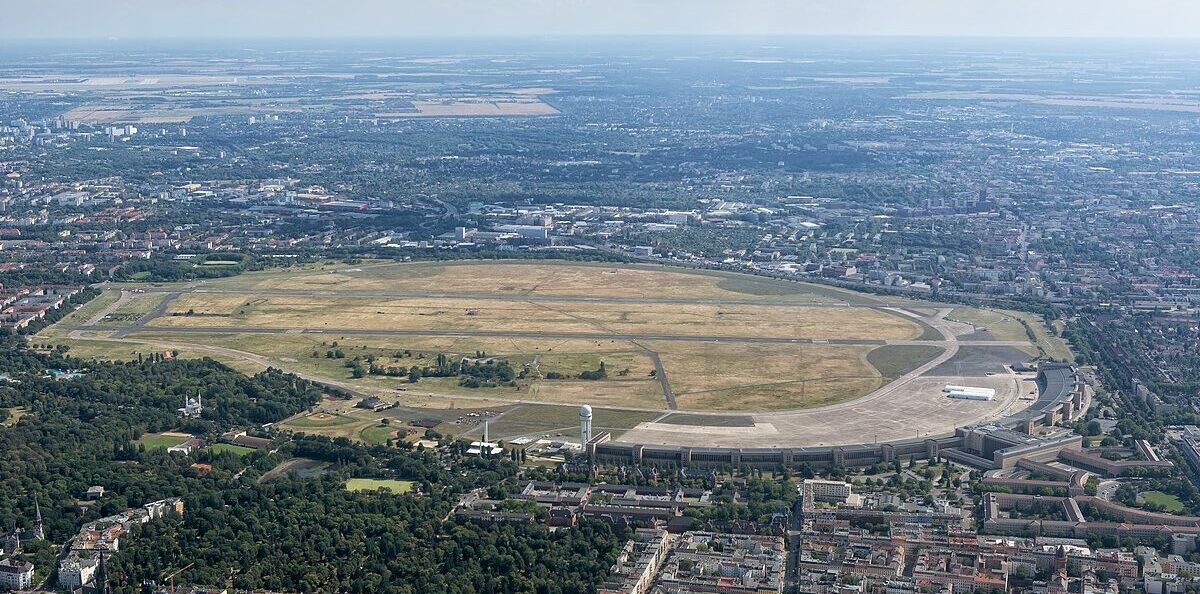What remains of Berlin-Tempelhof airport, one hundred years later

Berlin's Tempelhof airport celebrated its first hundred years, even though it has now been retired for sixteen years, since its funeral was celebrated in 2007 with a ceremony that was more sad than solemn. Pierluigi Mennitti's reportage
Along the long asphalt trail of one of the two take-off and landing runways glide skateboard fanatics, athletes on roller skates, inattentive cyclists, groups with picnic bags, children with parents at their side and kites on a leash, delightful grannies clinging tenaciously to the walker. There is room for everyone on the old layout of Tempelhof Airport.
Where once the engines of the Rosinenbomben roared, the Allied planes that tore Stalin's blockade of West Berlin from the sky in 1948, an infinite field of almost 400 hectares now extends. They call it a park, even though it has little or nothing of a park: not a tree, nor a botanical path, not even a flowerbed. It is an enormous indefinite space onto which urban visions of the future Berlin are projected, punctually destined to vanish.
Because every idea of a housing settlement foundered in the face of citizens' protests. In reality, Berliners seem to like the Tempelhof space as it is, a non-park freed from the temptations of speculators where they can spend their free time without too many demands. A sort of unplanned place, an immense large unbuilt hole in the middle (or almost) of the metropolis, a belated memory of the many free urban spaces filled by the constructive fury that has infected planners since the fall of the Wall. If you like, a reaction from below to the unshared decisions of administrators, a challenge full of skepticism to representative politics.
Berliners storm it every weekend. Its hangars and boarding lounges are periodically home to small fairs, some more remote areas have been transformed into reception centers for the thousands of refugees who reach Berlin, a cultural center organizes theater and dance shows, its large outdoor spaces in spring and summer they host concerts and happenings that attract tens of thousands of young people.
But the ghost of the airport is always there, symbolized by the enormous terminal now crystallized by the constraint of protection of cultural heritage, and by a couple of vintage planes vented like whales beached on the square in front of the old gates .
The Berlin Tempelhof Flughafen celebrated its first hundred years, even though it has now been retired for sixteen years, since its funeral was celebrated in 2007 with a ceremony that was more sad than solemn. The old Tempelhof was no longer needed and would have been the first of the three historic airports to close its doors to make way for the new airport outside the city. The fact that it took almost fifteen years for the inauguration of the Willy Brandt is ultimately another story.
The program of celebrations was extensive: five days of 1920s-style parties , film screenings, book presentations, concerts, shows with DJs and live radio broadcasts, as well as obviously plenty of offers for children. Now that its centenary is being celebrated, everyone remembers the phrase of the architect Norman Foster who defined it as "the mother of all airports". Here Berlin marked the epics and above all the dramas of its twentieth century. Tempelhof was actually born in 1923 from an open space for the beginnings of civil and military aviation at the beginning of the twentieth century and was embellished in 1927 with a small building for departures. Adolf Hitler's megalomania transformed it into the airport of the Third Reich in the 1930s, with the sumptuous terminal now under artistic protection. The Soviets proudly occupied it in the Battle of Berlin and then handed it over to the Americans in the division of the city.
The Americans liked this little architectural jewel. The two runways were perfect for the aircraft of the time, you landed and roared up to the large arched apron which replicated the central structure of the terminal. Thus began the American Tempelhof era. The first American Overseas Airlines flight departed from those runways, inaugurating the line to New York in May 1946: the dawn of a new era.
But Tempelhof's fame had yet to reach its peak, the moment that will remain etched in the history books: the airlift. For over a year, from June 1948 to the end of September 1949, 278,228 planes taking off from airports in the United States, France and Great Britain unloaded 2,326,406 tons of coal for heating, food, supplies, machinery and medicine. The photos of the Berliners crowded on the hill in front of the landing strips, with their hands raised to the sky in greeting, testify to the emotion of the moment.
The development of large intercontinental aircraft marked its decline, relegating the airport to a regional airport. The final blow, however, came with the fall of the Wall: the new capital wanted to equip itself with a new modern airport. Of the three ports of Cold War Berlin (two in the west, one in the east), only Tempelhof closed its doors early. The other two (Tegel and Schönefeld) remained in business until three years ago, because the inauguration of the new airport named after Willy Brandt dragged scandalously from 2011 to 2020. Seen from the Tempelhof kites, it seemed like a wicked revenge.
This is a machine translation from Italian language of a post published on Start Magazine at the URL https://www.startmag.it/mondo/aeroporto-berlino-tempelhof-100-anni/ on Sat, 28 Oct 2023 05:02:42 +0000.
